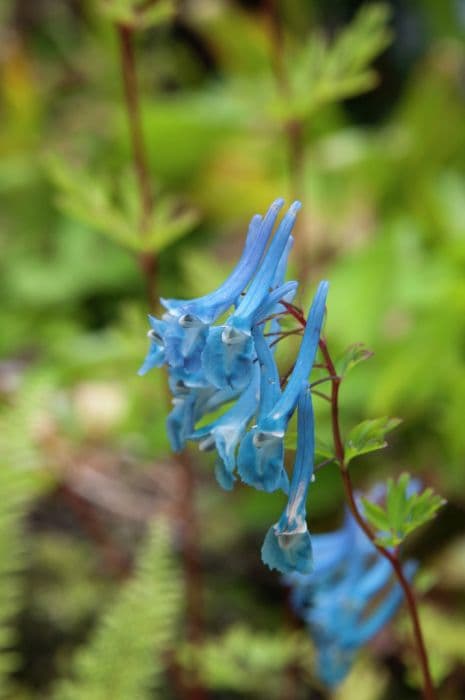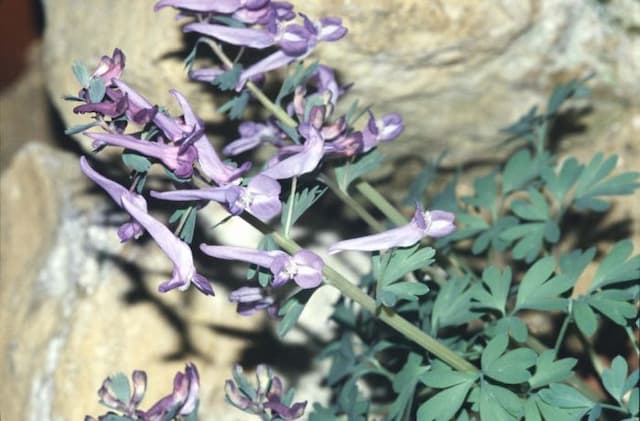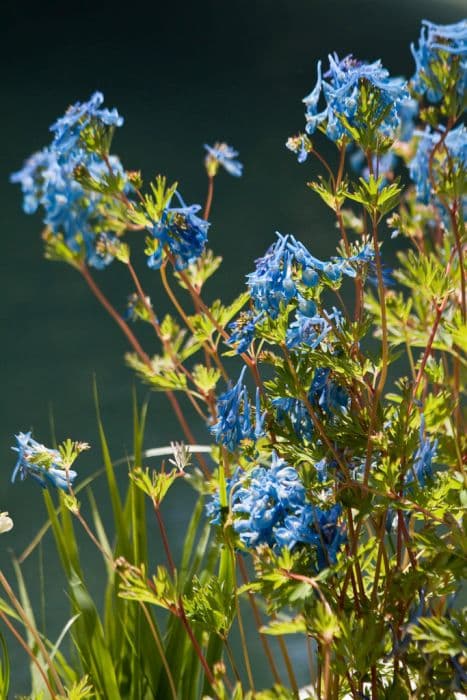Blue Poppy Meconopsis (George Sherriff Group) 'Jimmy Bayne'

ABOUT
The plant commonly known as 'Jimmy Bayne' boasts a stunning display of blooms characterized by their vibrant blue petals that can sometimes exhibit hints of purple. These flowers are large and borne singularly on stems that rise above the base of the plant. Each bloom has a distinct set of yellow stamens at its center, further accentuating their beauty and providing a striking contrast against the blue petals. The foliage of 'Jimmy Bayne' is equally attractive, featuring leaves that are elongated and possess a delicate texture. These leaves typically present in a lush, deep green shade which forms a rosette-like arrangement at the base of the plant, creating a dense and rich ground cover. The striking appearance of 'Jimmy Bayne' makes it a jewel among garden plants, with its beautiful blue flowers attracting admirers and its foliage providing a backdrop that complements its floral display.
About this plant
 Names
NamesFamily
Papaveraceae
Synonyms
Himalayan Blue Poppy, Tibetan Blue Poppy, Blue Poppy
Common names
Meconopsis 'Jimmy Bayne'
 Toxicity
ToxicityTo humans
The Meconopsis, commonly known as Himalayan blue poppy, does not have a well-documented profile of toxicity to humans. There is little evidence to suggest it is harmful when touched or ingested. However, as with any plant, individuals may have varying sensitivities or allergic reactions. If ingested and adverse symptoms are experienced, seeking medical advice is recommended.
To pets
The Himalayan blue poppy is not widely known to be toxic to pets. There is a lack of substantial information regarding its effects if ingested by animals. Just as with humans, pets may have individual allergies or sensitivities, so it is sensible to prevent pets from ingesting plants. If a pet does consume part of the plant and exhibits signs of distress, contacting a veterinarian is advised.
 Characteristics
CharacteristicsLife cycle
Perennials
Foliage type
Deciduous
Color of leaves
Green
Flower color
Blue
Height
3 feet (0.91 meters)
Spread
1 foot (0.30 meters)
Plant type
Herb
Hardiness zones
7
Native area
Tibet
Benefits
 General Benefits
General Benefits- Ornamental Appeal: The Meconopsis, commonly known as Blue Poppy, offers a striking blue floral display that is a standout in any garden.
- Biodiversity Support: It attracts pollinators, including bees and butterflies, which are essential for the pollination of plants and the overall health of gardens.
- Mood Enhancement: The vivid colors and unique appearance can lift spirits and enhance the aesthetic of a garden space, contributing positively to mental well-being.
- Educational Interest: Gardeners and botanists can learn about alpine flora and the conditions required for the growth of unique plants like the Blue Poppy.
- Landscape Design: With its distinctive flowers, the plant can be used effectively in garden design, adding texture, color, and height variation to planting schemes.
- Seasonal Interest: It provides seasonal bloom that can be timed to create year-round interest in the garden, depending on the climate and location.
- Cultural Significance: In some cultures, poppies symbolize remembrance and peace, making this plant significant beyond its aesthetic value.
 Medical Properties
Medical PropertiesThis plant is not used for medical purposes.
 Air-purifying Qualities
Air-purifying QualitiesThis plant is not specifically known for air purifying qualities.
 Other Uses
Other Uses- Photography subject: Due to its striking blue or purple flowers, it is often used by photographers seeking to capture beauty in alpine plant life.
- Ecosystem support: Provides nectar and pollen for various species of bees, which are essential pollinators in their native habitats.
- Thematic gardens: Meconopsis 'Jimmy Bayne' adds a unique element to rock gardens or blue-themed botanical collections.
- Symbolic plantings: In some cultures, the blue poppy (Meconopsis) symbolizes peace and tranquility and is used in gardens designed for meditation and reflection.
- Educational use: Botanical gardens often use this species to educate the public on high-altitude flora and plant adaptation mechanisms.
- Artistic inspiration: The dramatic appearance of the blue poppy inspires artists and is featured in various forms of artwork, including paintings and sculptures.
- Seed trading: Enthusiasts of alpine plants commonly trade seeds of this variety, promoting biodiversity and conservation through hobbyist gardening.
- Dye production: The petals of Meconopsis have been used in some traditional practices to create natural dyes for fabrics, giving a soft blue hue.
- Climate change research: As a high-altitude plant, Mecenopsis 'Jimmy Bayne' is studied to understand the impact of climate change on mountain flora.
- Culinary decoration: Although not a common practice, the petals of Meconopsis can be used to add a splash of color to salads or desserts in high-end culinary establishments.
Interesting Facts
 Feng Shui
Feng ShuiThe Blue Poppy is not used in Feng Shui practice.
 Zodiac Sign Compitability
Zodiac Sign CompitabilityThe Blue Poppy is not used in astrology practice.
 Plant Symbolism
Plant Symbolism- Rarity and Exclusivity: Meconopsis, commonly known as Himalayan Blue Poppy, is a rare and exclusive plant due to the challenge it poses for gardeners to grow, symbolizing the preciousness and value of rare beauty.
- Tranquility: The blue color of the Himalayan Blue Poppy is often associated with calmness and peace, offering a sense of tranquility to those who view it.
- Dreaminess: The ethereal appearance of the bloom can represent dreaminess, encouraging daydreams and the pursuit of impossible-seeming goals or ideas.
 Water
WaterThe Blue Poppy, including 'Jimmy Bayne', requires consistently moist soil, so it is essential to water it whenever the top inch of soil feels dry to the touch, which may be about once or twice a week, depending on the climate and weather conditions. Use gentle watering methods to avoid disturbing the soil or damaging the delicate foliage and flowers. Provide water at the base of the plant, ensuring that you saturate the soil to a depth of several inches. The amount needed will vary, but aim for approximately one gallon of water every week during the growing season, adjusting as necessary for rainfall or temperature changes.
 Light
LightThe Blue Poppy thrives in bright, indirect light with some shelter from the intense midday sun. A location that receives morning sunlight and dappled shade in the afternoon is ideal. Avoid placing it in full shade or full sun, as both conditions can be detrimental to its growth.
 Temperature
TemperatureBlue Poppies prefer cool to moderate temperatures, with optimal growth occurring between 50°F and 65°F. They can tolerate cold down to 32°F but should be protected from frost. They do not perform well in temperatures exceeding 75°F, so during hot spells, provide shade or move the plant to a cooler location.
 Pruning
PruningPruning Blue Poppies is generally done to remove spent flowers and maintain plant shape. Deadhead regularly to encourage more blooms and extend the flowering period. Cut back the foliage after blooming has finished in late summer to help the plant conserve energy. Pruning can be done as needed, usually every few weeks during the flowering season.
 Cleaning
CleaningAs needed
 Soil
SoilThe Himalayan Blue Poppy requires a soil mix rich in organic matter with good drainage; a blend of equal parts loam, peat moss, and perlite or grit is suitable. The soil pH should be slightly acidic to neutral, ranging from 6.0 to 7.0 for optimal growth.
 Repotting
RepottingHimalayan Blue Poppies should be repotted every 1-2 years in spring, using fresh soil mix to replenish nutrients and prevent soil compaction, which can affect root health.
 Humidity & Misting
Humidity & MistingHimalayan Blue Poppies thrive in high humidity environments; aim for a humidity level around 70-80% to mimic their native mountainous conditions, which they prefer.
 Suitable locations
Suitable locationsIndoor
Use acidic soil, cool temps, and bright, indirect light.
Outdoor
Plant in dappled shade, moist, well-drained, acidic soil.
Hardiness zone
5-7 USDA
 Life cycle
Life cycleThe Meconopsis 'Jimmy Bayne', commonly known as Himalayan Blue Poppy, begins its life cycle when seeds germinate, usually necessitating a period of cold stratification to break dormancy. After germination, seedlings develop into a rosette of leaves during the first growing season, establishing a root system and foliage. In the second or subsequent years, the plant enters the vegetative stage, where it continues to grow leaves and strengthen its root system. Upon reaching maturity, usually in the second year, it produces tall flower stalks bearing the iconic blue flowers for which it is known. After flowering, which occurs in late spring to early summer, the plant sets seed, which are dispersed by wind or gravity. Most Meconopsis are monocarpic, meaning they die after setting seed, but some can behave as short-lived perennials, potentially creating new foliage and flowering again if conditions are favorable.
 Propogation
PropogationPropogation time
Spring to early summer
The most popular method of propagation for the Meconopsis, commonly known as the Blue Poppy, specifically the 'Jimmy Bayne' cultivar, is by sowing seeds. Seeds should be sown as soon as they are ripe, usually in late summer, to maximize germination rates. The seeds need a period of cold stratification, which can be naturally provided if the seeds are sown outdoors in fall. Indoors, stratification can be simulated by placing the seed container in a refrigerator (at about 40 degrees Fahrenheit or 4 degrees Celsius) for about four to six weeks. After cold treatment, the seeds should be surface sown onto a moist, well-draining seed mix and kept under bright, indirect light at cool temperatures. Germination can be erratic, often taking weeks or even months, so patience is essential when propagating Blue Poppies from seed.









